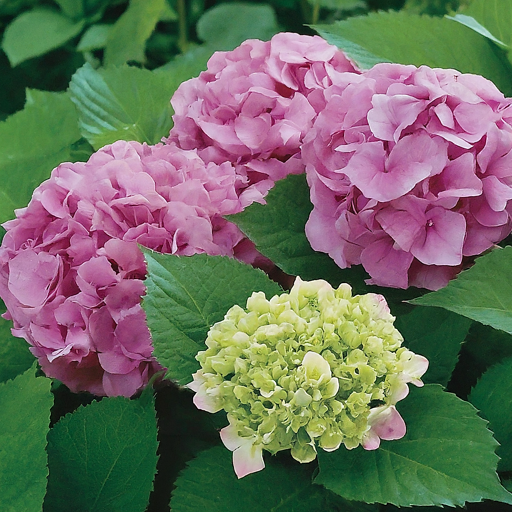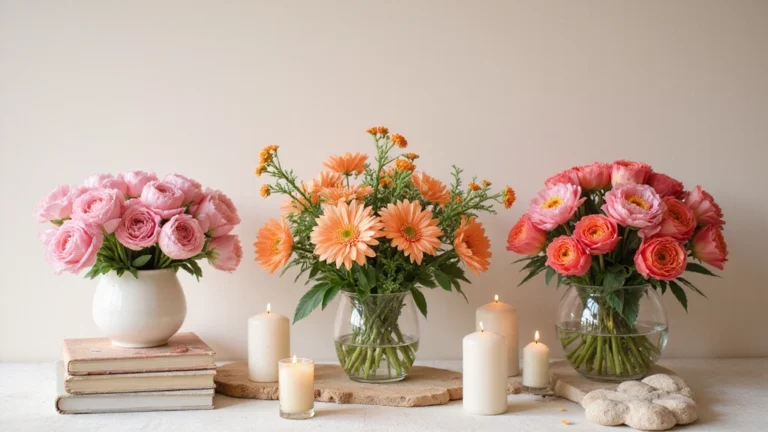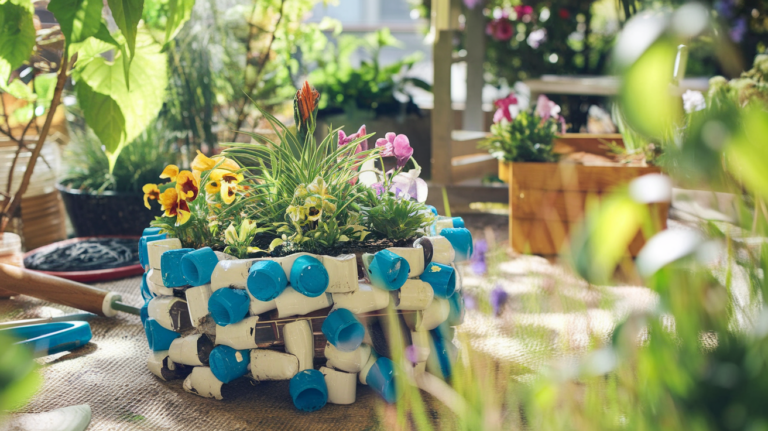What to Plant with Hydrangeas? 21 Ideas

What to plant with hydrangeas? This is a common question among gardeners looking to add color and interest to their garden.
Hydrangeas are a popular ornamental plant that produces large, showy flowers in shades of pink, white, blue, and purple.
They are relatively easy to grow and can add a touch of elegance and charm to any landscape.
But many gardeners struggle with what to plant around their hydrangeas.
Hydrangeas are large, bushy plants that can take up a lot of space, so it’s important to choose companion plants that won’t get crowded out.
In this article, we’ll introduce you to 21 beautiful plants that pair well with hydrangeas.
Whether you’re looking for ground covers, perennials, shrubs, or trees, we’ve got you covered!
1. Southern Living Plant Collection

The Southern Living Plant Collection is a great place to look for hydrangea companion plants.
This collection is designed to thrive in the South, so you know that they’ll do well in the same conditions that hydrangeas love.
A few of my favorite plants from the Southern Living Plant Collection to pair with hydrangeas are the ‘Diamond Spire’ Gardenia and the ‘Sunshine’ Ligustrum.
These three plants look amazing together and they all have the same care requirements.
2. Azaleas

Azaleas and hydrangeas are both popular spring-flowering shrubs that are often used in the same types of landscape designs.
Azaleas bloom earlier than hydrangeas, so planting them together is a great way to extend the blooming season in your garden.
You can also choose from a wide variety of azalea colors, from soft pinks and purples to bright reds and oranges,
so they look stunning when planted next to hydrangeas.
3. Boxwood

Boxwood and hydrangeas are a classic pairing. Boxwood is a versatile evergreen shrub that can be used as a hedge, topiary, or in a garden bed.
It’s a great way to add structure and greenery to your hydrangea garden. You can also use boxwood to create a border around your hydrangeas.
4. Camellias

Camellias grow well with hydrangeas because they have similar care needs. They both like to be in partly shaded areas, and they also like acidic soils.
Camellias are slow-growing, which makes them the perfect companion for hydrangeas. They won’t take away any nutrients from your hydrangea plants.
5. Hostas

Hostas are shade-loving perennials that come in a wide variety of colors and sizes.
They are easy to grow and do well in the same conditions that hydrangeas do.
Hostas are great for adding texture and color to your garden.
They are perfect for filling in empty spaces around your hydrangeas and can be used as a living mulch to help retain moisture in the soil.
Planting hostas with your hydrangeas is a great way to create a lush, full look in your garden.
6. Japanese Maples

Japanese maples are a popular choice for planting with hydrangeas.
These small trees are slow-growing and come in a variety of colors and textures, making them a great addition to any garden.
Japanese maples are a great plant to pair with hydrangeas because they have similar light and water needs.
They also provide a beautiful backdrop for the showy blooms of hydrangeas.
Japanese maples are also known for their stunning fall color, which can add even more visual interest to your garden.
7. Other Hydrangeas

If you’re a hydrangea lover, you might want to plant a few varieties of this beautiful flowering shrub.
Hydrangeas come in a variety of colors and bloom shapes, and they can make a stunning hedge.
8. Peonies

Hydrangeas and peonies are a classic combination. Both plants are perfect for cottage gardens and share the same growing conditions.
When planting peonies and hydrangeas together, make sure to give them plenty of room to grow.
Peonies are perennials and will come back year after year, but they can get quite large and may need to be divided every few years.
9. Roses

Roses are one of the most popular flowers in the world, and they are a beautiful companion for hydrangeas.
Roses and hydrangeas are both popular in the garden and are often grown together.
They have similar growing conditions and can be planted in the same bed.
Roses and hydrangeas are both easy to grow and low maintenance, making them a great pair.
10. Spirea

Spirea is another shrub that pairs well with hydrangeas.
These two shrubs have similar watering and sunlight needs, so they will make a great pair in your garden.
Spirea comes in many different varieties, so you can choose one that will complement the color of your hydrangeas.
Spirea has a very delicate and lacy appearance, so it makes a great contrast to the bold blooms of hydrangeas.
11. SunPatiens
SunPatiens are a great annual to pair with hydrangeas. They are low maintenance and will bloom all season long.
SunPatiens are a great way to fill in the area around your hydrangeas while they are still young.
Once your hydrangeas have reached their mature size, you can plant your annuals closer to the base of the plant.
12. Astilbe
Astilbe is a low-growing, shade-loving perennial that has fern-like foliage and produces tall, feathery flowers in a range of colors.
This plant is perfect for pairing with hydrangeas because it adds a vertical element to the garden and comes in a variety of colors that can complement the hydrangea blooms.
Astilbe is also a great plant for filling in any gaps in the garden.
It is low-growing, so it won’t compete with the hydrangeas, but it will help to create a lush, full look.
13. Bleeding Heart
Bleeding heart is a beautiful perennial that’s perfect for planting with hydrangeas.
The delicate, fern-like foliage and heart-shaped flowers of bleeding heart provide a nice contrast to the large, lush leaves and showy blooms of hydrangeas.
Bleeding heart flowers are available in pink, red, or white, so you can choose the color that best complements your hydrangeas.
This perennial grows best in partial shade and moist, well-draining soil, making it a perfect companion for hydrangeas.
14. Brunnera
Brunnera is a shade-loving perennial that is often used as a ground cover. It has large, heart-shaped leaves that are a beautiful blue-green color.
Brunnera blooms in spring and has small, delicate, light blue flowers that look like forget-me-nots.
It can be planted in front of hydrangeas to add some interest to the lower levels of the garden.
15. Clematis
Clematis is a popular flowering vine that can be planted with hydrangeas.
Both clematis and hydrangeas can thrive in the same growing conditions, so they make great companion plants.
Clematis are available in a variety of different colors, and they can be trained to climb up a trellis, arbor, or pergola in your garden.
When you plant clematis with hydrangeas, you can create a beautiful, multi-tiered garden design.
16. Coral Bells
Coral bells are a shade-loving perennial that comes in a variety of colors and textures.
They also come in a range of sizes, so you can pick one that won’t overpower your hydrangeas.
Most coral bells grow to be about 12-18 inches tall and wide and produce flowers in the summer.
However, they are grown for their foliage and can provide interest in your garden even when not in bloom.
17. Daylilies
Daylilies (Hemerocallis) are one of the most popular perennials in the United States. They come in a wide range of colors and are extremely easy to grow.
Planting daylilies with hydrangeas is a great way to add some color to your garden.
You can choose daylilies in colors that complement your hydrangeas, or you can go for a more monochromatic look.
Daylilies are also great for adding some texture to your garden.
The long, strap-like leaves of daylilies provide a nice contrast to the large, lush leaves of hydrangeas.
18. Ferns
Ferns are another great plant to pair with hydrangeas. Like hostas, they are shade-loving, low-growing, and add a nice texture to the garden.
You can plant ferns in the ground or in containers. There are many different varieties of ferns, so you can mix and match them to create a unique look.
19. Foxglove
Foxglove is a tall, elegant perennial that adds height to your hydrangea garden. It produces spires of bell-shaped flowers that are often white, pink, and purple.
Foxglove prefers partial to full shade and well-drained soil. It’s a great choice if you want to add a cottage garden feel to your hydrangea garden.
20. Ligularia
Ligularia is a great choice for planting with hydrangeas because it likes the same growing conditions.
Ligularia is a shade-loving perennial that prefers moist, well-draining soil.
Ligularia has large, heart-shaped leaves that add a nice contrast to the hydrangea’s foliage.
This plant also has tall, spiky flowers that add some height and visual interest to the hydrangea bed.
21. Solomon’s Seal
If you’re looking for a ground cover to plant with your hydrangeas, consider Solomon’s Seal.
This plant has a unique, arching form and bright green leaves that make it a great choice for filling in the empty spaces in your garden.
Solomon’s Seal produces small, white flowers that will look lovely with your hydrangeas. It’s also a great choice for gardens in shady areas.
What to Plant with Hydrangeas: Final Thoughts
Hydrangeas are a beautiful and versatile shrub that can be planted in a variety of ways.
Whether you’re planting a new garden or adding to an existing one, there are many different plants that will complement your hydrangeas beautifully.
From annuals to perennials, groundcovers to vines, there are so many different options to choose from.
Use this list as a starting point and see where your creativity takes you!
Conclusion
Hydrangeas are such versatile plants that you can easily pair them with many other flowers.
Whether you want to create a romantic, cottage garden or a more formal, structured design, there are plenty of options to choose from.
Plus, many of these flowers are easy to grow, so you can enjoy a beautiful garden without too much effort.






